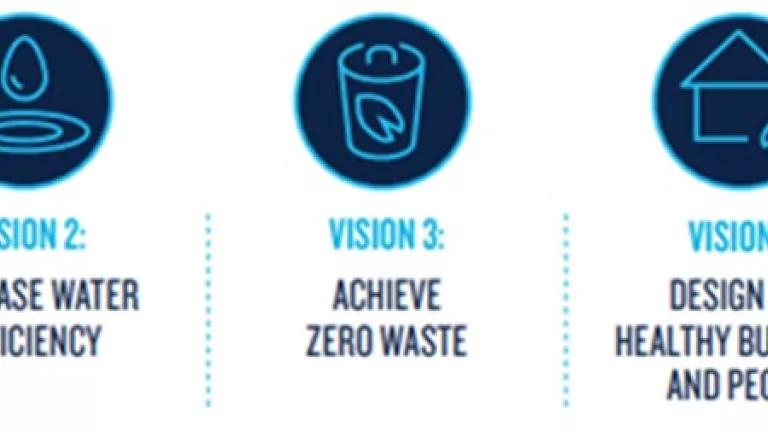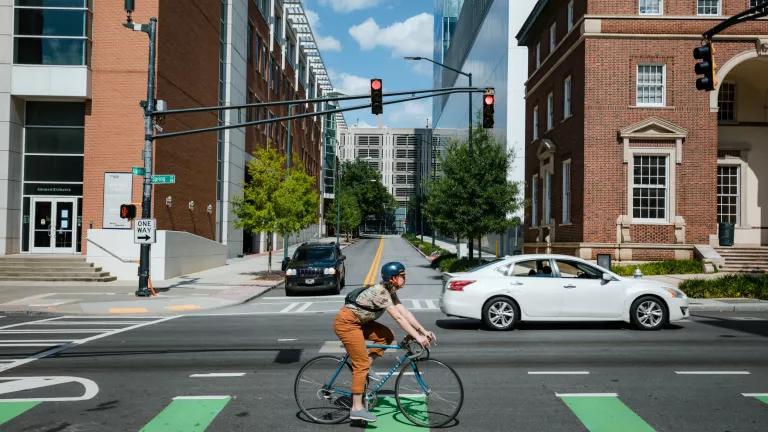Sustainable Operations: Helping Business Bloom
Organizations, like NRDC, that implement sustainability outperform their counterparts over the long-term.

NRDC Sustainable Operations Visions
Business sustainability has become a topic executives and environmentalist can agree on. According to the current IPCC report “rapid and far-reaching” changes must to take place in how we managed land, energy, buildings, and transport for us to meet the global carbon reduction goals. Trends show that in almost every industry the adoption of sustainable practices are prompted more by market leaders than by the government [1] For the organizations that implement environmentally friendly practices, it is evident that they outperform their counterparts over the long-term. [2] For these reasons, we know it is crucial to have sustainability be a fundamental part of our organization and as a larger paradigm shift.
Our third formal iteration of the NRDC Sustainable Operations Plan provides full transparency into how our internal operations consider the triple bottom line: environmental, social, and economic impact. We work to reduce our environmental impact stemming from our building operations and travel. We work to increase our positive social impact on staff and community health. And lastly, we minimize costs wherever possible without sacrificing our environmental and social responsibility.
The five comprehensive visions of the Plan represent our ideals and guide to action:
Each vision is supported by three approaches that outline the strategies and actions required to ensure the Visions become a reality. It is important to highlight that Visions 1 through 4 have supplementary documents that give greater detail into our timeline and execution. These documents include but are not limited to our: Zero Waste Directive, Procurement Policy, Design and Construction Protocols, and Travel Policy.
To bring the NRDC Sustainable Operations Plan to the global conversation of sustainable development, we have identified six United Nations Sustainable Development Goals that the Plan’s visions align with:

UN Sustainable Development Goals
It is important that we have one voice in our fight against the challenges of ensuring equitable economic growth, environmental sustainability, and containing the effects of human-induced climate deterioration.
Between 2016—when the second iteration of the NRDC Sustainable Operations Plan was published—and now, our organization has continued to make progress:
- 2016 – Our Chicago, IL office was expanded and became the first project in the world to achieve Petal Certification with the Materials Petal under the 3.0 version of the Living Building Challenge. Our offices in San Francisco, CA and Beijing, China have also achieved Petal Certification under the Living Building Challenge.
- 2018 – Our Santa Monica, CA office achieved operational zero waste through diverting 90 percent of our waste from incineration and landfills. This was done through limiting the total amount of waste generated and responsibly managing all unwanted or unusable materials.
- 2019 – Our New York City, NY headquarters is projected to reach net-zero energy this winter. Once achieved it will use 100% solar energy and any excess energy not used by our headquarters will be fed back into the electrical grid. We are working to complete this 890,000 kWh/year remote net metering solar array in the Bronx borough with the help of OnForce Solar. During the solar array’s 25-year lifetime it will prevent 17,325 metric tons of greenhouse gas emissions from being released into our atmosphere.
Overall, there has been a decrease in the environmental damage we cause through our building emissions (down 31 percent), water consumption (down 32 percent), and waste sent to the landfill (down 27 percent) since 2012. Each day we make every effort to sustain this trend. Ecological footprints reach far beyond their immediate surroundings and the cost of environmental protection will always be less than the cost of environmental damage.[3]
As the Harvard Business Review summarizes perfectly, “being green is no longer a cost of doing business; it is a catalyst for innovation, new market opportunity, and wealth creation”. At NRDC we strive to demonstrate leadership through our daily practices while continuing to advocate for education and equal access to sustainability. We believe market transformation is on the green horizon.
To learn more about NRDC’s sustainability efforts or to contact the team, visit www.nrdc.org/our-sustainability
[1] https://papers.ssrn.com/sol3/papers.cfm?abstract_id=3312191
[2] https://www.hbs.edu/faculty/Publication%20Files/SSRN-id1964011_6791edac-7daa-4603-a220-4a0c6c7a3f7a.pdf
3] Huber, J. 2000, "Towards industrial ecology: sustainable development as a concept of ecological modernization", Journal of Environmental Policy & Planning, vol. 2, no. 4, pp. 269-285.



